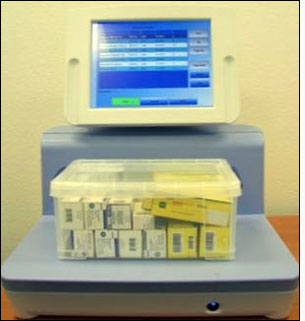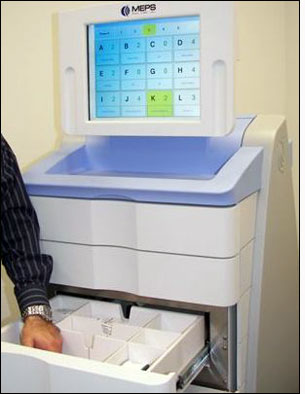There are some drugs that hospitals seldom administer, but that are nonetheless vital to have ready. These medications—such as rabies vaccines, blood factors and snakebite antivenom—not only are expensive, but also sometimes have a short shelf life. Consequently, their stock levels must be managed closely and carefully.
To simplify this task, a San Diego hospital is testing an RFID-based drug-management system developed by MEPS Real-Time, an RFID solutions provider based in Carlsbad, Calif. The system, known as Intelliguard, employs standard EPC Gen 2 ultrahigh-frequency (UHF) passive RFID tags and readers, including a tabletop reader for commissioning the tag attached to each drug’s packaging, as well as RFID-enabled drug-dispensing cabinets and bedside patient trays.

Designed for use within patient rooms, the bedside tray is mounted to a wheeled pedestal and has a built-in video screen and an embedded RFID interrogator to read tags attached to drugs administered to a patient, as well as an RFID tag embedded in that individual’s ID wristband, to ensure that the correct medications are being dispensed. (The San Diego facility is not using Intelliguard bedside trays during its pilot.) The system also includes the Intelliguard software platform, enabling the hospital’s staff to associate the RFID tag number encoded to the tag attached to each unit of medication with that product’s national drug code, expiry date and other information. MEPS Real-Time says the software, developed in-house, is compliant with the Health Level Seven International (HL7) standards, and is based on the .NET platform.
The San Diego hospital launched the pilot in mid-December 2010, and plans to continue running it for approximately four months, in order to evaluate the Intelliguard system, says the hospital’s pharmacy director, who has requested that he and his hospital not be named during this phase of the pilot. Currently, the organization is tagging and tracking a total of 40 types of high-value, slow-moving drugs are being tagged and tracked. As the hospital’s pharmacy receives these products from suppliers, a staff member attaches an RFID label (MEPS sources its labels from a variety of vendors) to each product, consisting of a single dose. The worker then places each tagged item on the tabletop reader, in order to collect the tag’s pre-encoded ID number, and utilizes the Intelliguard software to associate that ID with information regarding that drug.
For now, the hospital is tagging only medicines that can be stored at room temperature. Once tagged and checked in, these drugs are placed into an Intelliguard storage cabinet. Starting next month, the facility plans to install a second cabinet that functions as a refrigerator. At that point, employees will also begin tagging and storing temperature-sensitive pharmaceuticals that must be refrigerated. A ThingMagic M6E EPC Gen 2 RFID reader is embedded into each cabinet, which has multiple drawers partitioned for containing drugs. The interrogator is set to scan the inside of the cabinet, in order to perform a daily inventory. What’s more, every time one of the cabinet’s drawers is opened and subsequently closed, the reader within that unit automatically reads that drawer’s contents for the purpose of updating inventory levels.
To ensure that an Intelliguard storage cabinet’s built-in interrogator reads only the tags on products stored within it (and not those of drugs that have been removed and are located elsewhere in the room), the cabinet contains RF shielding that restricts the reader’s UHF transmissions to the cabinet’s interior, and the device operates only when the drawers are closed.
The pilot’s objective is to ascertain whether the RFID system could aid the hospital staff in better managing the inventory and administration of these pharmaceuticals—in other words, enable it to know where the drugs are, as well as the amount of each product available in stock at all times—so that it can reduce the quantity of items that are never administered due to having exceeded their expiration date.
“It has always been my intention to try to have a system that can reduce medications from expiring, unused,” the hospital’s pharmacy director explains.
Expired pharmaceuticals are returned to a reverse vendor. Some drug companies issue a partial credit for expired products that have been returned, but it’s still a source of revenue loss that the hospital would like to stem. By using Intelliguard to better manage the stock levels of these medicines, the medical center hopes to maintain a smaller stock, thereby reducing the frequency at which any of the drugs remain on the shelf past their expiry date.

“The RFID system will know when something is low, and there will be daily reports,” the pharmacy director states. “We will run a more just-in-time inventory—and if we get our turnover up, then there’s a reduction in cost of capital.”
Following the pilot’s completion, if the hospital chooses to begin using the Intelliguard system to track these drugs on a permanent basis, it would replace a kanban system that the facility had employed prior to the pilot. With this system, a worker placed a card within a bin each time one of these medicines was removed from a shelf inside a cabinet or refrigerator. This card indicated to pharmacy staff members conducting regular inventory counts that the item had been removed. In addition to negating the need to perform this manual inventory, the Intelliguard system automates the reordering process so that the hospital can ensure it always has an adequate supply of the drug in stock.
Founded in 2001, MEPS Real-Time spun out from Safety Syringes, which manufactures needle guards for pharmaceutical syringes. MEPS’ initial products were based on passive 13.56 MHz high-frequency (HF) RFID tags, says Shariq Hussain, the firm’s president. But while these transponders operated well when affixed to packaging of liquid medicines, the quantity of 13.56 MHz tags that could be consistently read within a storage cabinet using an embedded reader was not as high as the company sought. Only approximately 30 to 40 HF tags, he says, could be read when attached to drug products and stored in close proximity to each other inside the cabinet.
The company then tested passive tags operating at 2.45 GHz, which functioned well during a hospital pilot test. The 2.45 GHz tags utilized proprietary technology, however, and MEPS decided it wanted to offer only standardized hardware. In 2008, the firm opted to move to EPC Gen 2 tags and readers because the hardware is standardized and the tags can be read consistently and in quantities—approximately 100 tags per drawer (a cabinet can have as many as eight drawers)—that the Intelliguard system requires.
According to Hussain, MEPS Real-Time developed its Intelliguard system so it could be used across the pharmaceutical supply chain, wherein trading partners would tag medications prior to shipping them to hospitals, so that the tags can then be used to create drug pedigrees and chains of custody. “We hope distributors and wholesalers will want to step up and participate in future pilots,” he states.

